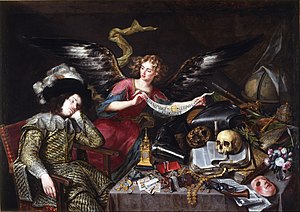Antonio de Pereda
Antonio de Pereda | |
|---|---|
 The Knight's Dream by Antonio de Pereda. On the banner: Aeterne pungit, cito volat et occidit. "Eternally it stings, swiftly it flies and it kills." | |
| Born | Antonio de Pereda y Salgado c. March 1611 Valladolid, Spain |
| Died | January 30, 1678 (aged 66–67) Madrid, Spain |
| Nationality | Spanish |
| Occupation | Painter |
Antonio de Pereda y Salgado (c. 1611 – January 30, 1678) was a Spanish Baroque-era painter,[1] best known for his still lifes.
Biography[]
Pereda was born in Valladolid, the eldest of three brothers from an artistic family. His father, mother and two brothers were all painters.[2] He was educated in Madrid by Pedro de las Cuevas and was taken under the protective wing of the influential Giovanni Battista Crescenzi.[2] After Crescenzi's death in 1635, Pereda was expelled from the court and began to take commissions from religious institutions.[2] As well as still lifes and religious paintings, Pereda was known for his historical paintings such as the Relief of Genoa (1635) which was painted for the Salón de Reinos of the Buen Retiro Palace in Madrid as part of the same series as Velázquez's Surrender of Breda.[3]
Works[]

- El Socorro a Génova, 1634
- , 1635, painted for the collection of series of Gothic kings at the Palacio del Buen Retiro, Museo del Prado.
- Desengaño de la vida, around 1634
- Immaculate (Immaculada), several paintings now at several museums including the Prado (1636 painting), the Museo de Ponce, Puerto Rico (1654 painting), Hospital de la Venerable Orden Tercera in Madrid (1657 painting), Lyon, Budapest, etc.
- Annunciation, 1637, Prado
- Los desposorios de la Virgen con San José, 1640
- San Jerónimo penitente and San Pedro liberado por el ángel, 1643, Prado.
- Profesión de la infanta Margarita con San Agustín y la Virgen en gloria, 1650, Convento de la Encarnación, Madrid.
- Curación de Tobías, Barnard Castle, Bowes Museum, 1652.
- San José (Saint Joseph), Madrid, Royal Palace, 1654.
- El Salvador, 1655, now at the Capilla del Cristo and at San Ginés church, Madrid.
- Santo Domingo en Soriano (St. Dominic in Soriano), 1655, Museo Cerralbo.
- Elías y los profetas de Baal (Elijah and the Prophets of Baal), 1659, Madrid, parroquia del Carmen y San Luis
- The Sacrifice of Isaac, Dallas Museum of Art
- San Francisco de Asís en la Porciúncula (St. Francis of Assisi and the Porziuncola), 1664, Museo de Valladolid.
- San Jerónimo y la visión del Juicio Final, 1668, private collection.
- San Guillermo de Aquitania (St. William of Aquitaine), 1672, Real Academia de Bellas Artes de San Fernando.
- Several paintings of Bodegón including the Museo d'Arte Antiga, Lisbon, Helsinki (bodegón de frutas y bodegón de cocina) and The Pushkin Museum, Moscow (bodegón de legumbres, 1651).
- Vanitas, (versions at Uffizi, Florence, where it has been attributed to Juan de Valdés Leal, and at the Museum of Fine Arts, Zaragoza), without date or signature, possibly corresponding to his final stage
- The Knight's Dream (El sueño del caballero), Museo de la Real Academia de Bellas Artes de San Fernando
- Canticle of Saint Simon, Musée Condé, Chantilly
- Saint Peter Repentant (San Pedro arrepentido), Museo de la Real Academia de Bellas Artes de San Fernando.[4]
Gallery[]
- Antonio de Pereda's works

Allegory of Vanity

Still Life with an Ebony Chest

St Anthony of Padua with Christ Child
References[]
| Wikimedia Commons has media related to Antonio de Pereda y Salgado. |
- ^ Antonio de Pereda Online
- ^ Jump up to: a b c Linda Mann Art Gallery-Antonio de Pereda
- ^ Web Gallery of Art, image collection, virtual museum, searchable database of European fine arts (1100-1850)
- ^ Fernando, Real Academia de BBAA de San. "Pereda y Salgado, Antonio de". Academia Colecciones (in Spanish). Retrieved 29 April 2020.
External links[]
- Scholarly articles about Antonio de Pereda both in web and PDF @ the Spanish Old Masters Gallery
- Antonio de Pereda on Artcyclopedia
- Jusepe de Ribera, 1591-1652, a full text exhibition catalog from The Metropolitan Museum of Art, which includes material on Antonio de Pereda (see index)
- Spanish Baroque painters
- 1611 births
- 1678 deaths


